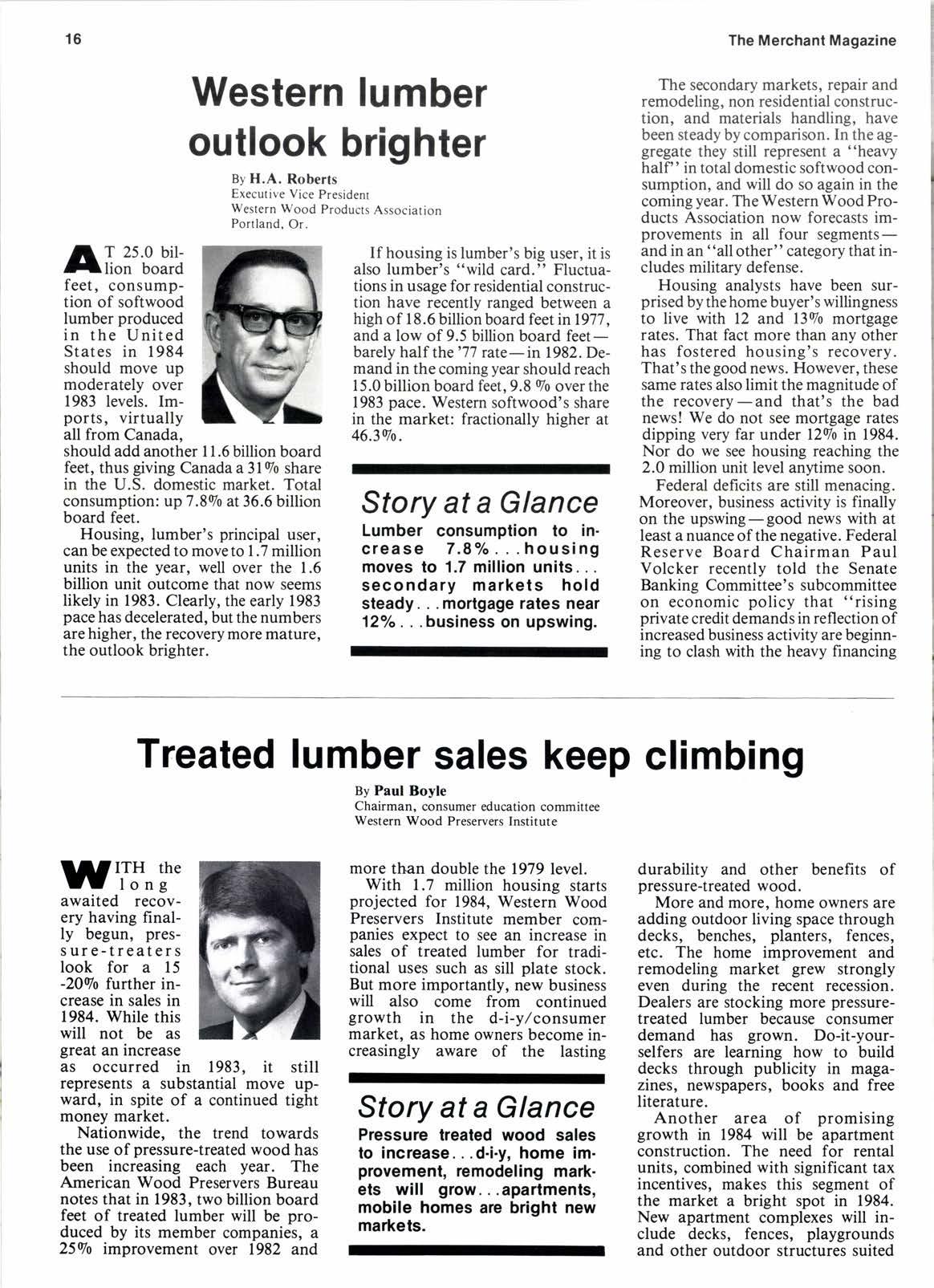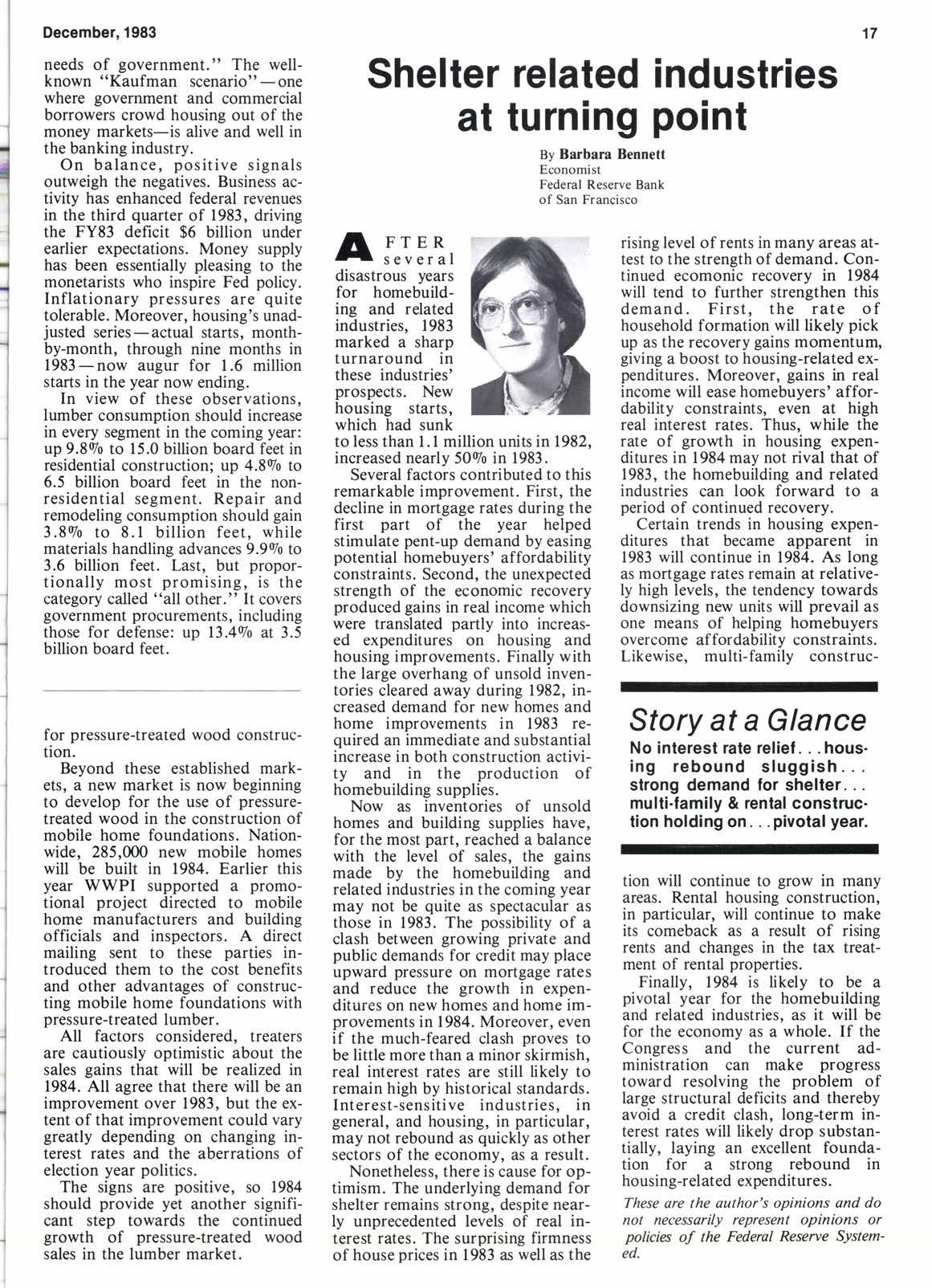
2 minute read
Treated lumber sales keep climbing
By Paul Boyle Chairman, consumer education committee Western Wood Preservers Institute
lllITH the UU longawaited recovery having finally begun, pressure-treaters look for a 15 -2090 further increase in sales in 1984. While this will not be as great an increase as occurred in 1983, it still represents a substantial move upward, in spite of a continued tight money market.
Nationwide, the trend towards the use of pressure-treated wood has been increasing each year. The American Wood Preservers Bureau notes that in 1983, two billion board feet of treated lumber will be produced by its member companies, a 250/o improvement over 1982 and more than double the 1979 level. With 1.7 million housing starts projected for 1984, Western Wood Preservers Institute member companies expect to see an increase in sales of treated lumber for traditional uses such as sill plate stock. But more importantly, new business will also come from continued growth in the d-i-ylconsumer market, as home owners become increasingly aware of the lasting
Story at a Glance
Pressure treated wood sales to increase...d-i-y, home improvement, remodeling markets will grow. .apartments, mobile homes arc bright new markets.
durability and other benefits of pressure-treated wood.
More and more, home owners are adding outdoor living space through decks, benches, planters, fences, etc. The home improvement and remodeling market grew strongly even during the recent recession. Dealers are stocking more pressuretreated lumber because consumer demand has grown. Do-it-yourselfers are learning how to build decks through publicity in magazines, newspapers, books and free literature.
Another area of promising growth in 1984 will be apartment construction. The need for rental units, combined with significant tax incentives, makes this segment of the market a bright spot in 1984. New apartment complexes will include decks, fences, playgrounds and other outdoor structures suited needs of government." The wellknown "Kaufman scenario"-one where government and commercial borrowers crowd housing out of the money markets-is alive and well in the banking industry.
On balance, positive signals outweigh the negatives. Business activity has enhanced federal revenues in the third quarter of 1983, driving the FY83 deficit $6 billion under earlier expectations. Money supply has been essentially pleasing to the monetarists who inspire Fed policy. Inflationary pressures are quite tolerable. Moreover, housing's unadjusted series-actual starts, monthby-month, through nine months in 1983-now augur for 1.6 million starts in the year now ending.
In view of these observations, lumber consumption should increase in every segment in the coming year: up 9.890 to 15.0 billion board feet in residential construction; up 4.890 to 6.5 billion board feet in the nonresidential segment. Repair and remodeling consumption should gain 3.890 to 8.1 billion feet, while materials handling advances 9.9s/o to 3.6 billion feet. Last, but proportionally most promising, is the category called "all other." It covers government procurements, including those for defense: up 13.490 at 3.5 billion board feet. for pressure-treated wood construction.
Beyond these established markets, a new market is now beginning to develop for the use of pressuretreated wood in the construction of mobile home foundations. Nationwide, 285,000 new mobile homes will be built in 1984. Earlier this year WWPI supported a promotional project directed to mobile home manufacturers and building officials and inspectors. A direct mailing sent to these parties introduced them to the cost benefits and other advantages of constructing mobile home foundations with pressure-treated lumber.
All factors considered, treaters are cautiously optimistic about the sales gains that will be realized in 1984. All agree that there will be an improvement over 1983, but the extent of that improvement could vary greatly depending on changing interest rates and the aberrations of election year politics.

The signs are positive, so 1984 should provide yet another significant step towards the continued growth of pressure-treated wood sales in the lumber market.










